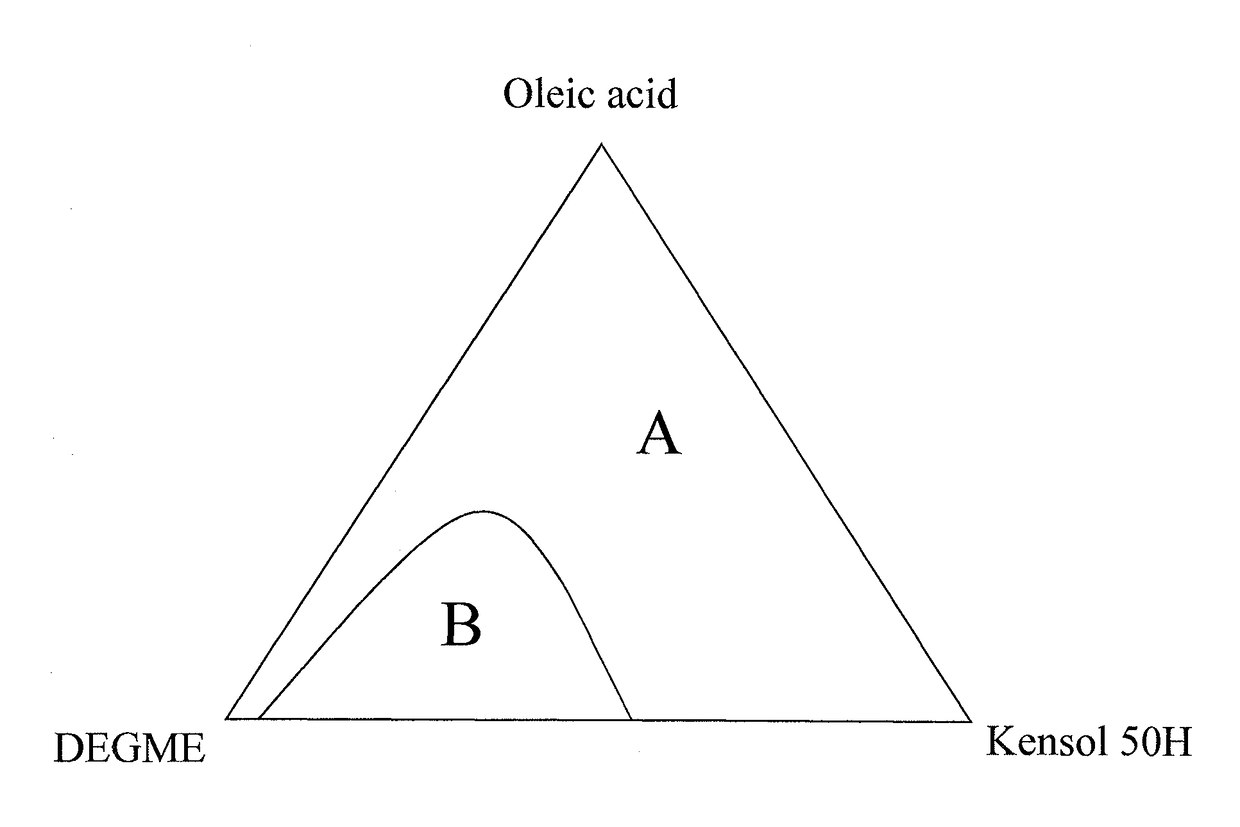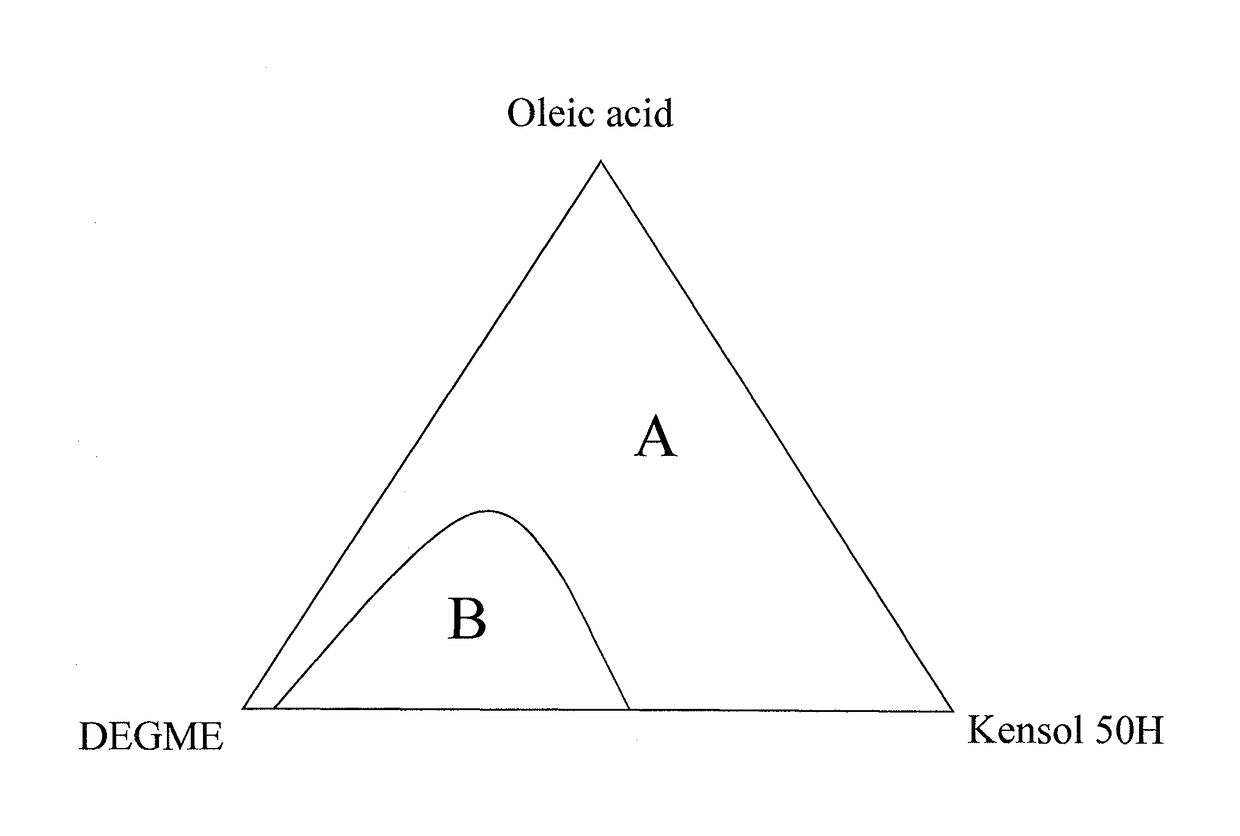Method for production of stable cerium oxide organic colloids
a cerium oxide and organic colloids technology, applied in colloidal chemistry, colloidal chemistry details, chemistry apparatus and processes, etc., can solve the problems of high cost of conventional aqueous processes, particle stabilizers used to prevent particle agglomeration in aqueous environment are not suitable for the task of stabilizing in a non-polar environment, and particles tend to immediately agglomerate, etc., to achieve simple, rapid, low temperature process
- Summary
- Abstract
- Description
- Claims
- Application Information
AI Technical Summary
Benefits of technology
Problems solved by technology
Method used
Image
Examples
example 1
[0046]A 100 ml aliquot of Ce0.6Fe0.40O(2-δ) aqueous nanoparticle dispersion prepared as described above, was added to a 500 ml reaction vessel and heated to a temperature of about 60° C. A 74.0 ml aliquot of Kensol® 50H and 37.6 g of oleic acid were then added, these two materials being at room temperature at the time of addition. The mixture was stirred by manual shaking of the vessel for a period of 1 minute, forming an emulsion. The emulsion mixture was then held at 40° C. to age for 2 hours. Then, 30 ml of DEGME was added to the emulsion and it separated in about 4 hours to yield a stable dark brown non-turbid substantially non-polar colloid phase, above a nearly colorless aqueous phase. The non-polar colloid phase was separated out by pipette. To 100 ml of the separated organic colloid phase was added 13.9 ml of DEGME and 7.2 ml of PGME. Long-term stability observations of samples of the above non-polar colloid were carried out while samples were held in separate 10 ml vials. O...
example 2
[0047]A 100 ml aliquot of Ce0.6Fe0.4O(2-δ) aqueous nanoparticle dispersion prepared as described above, was added to a 500 ml reaction vessel and heated to a temperature of about 60° C. A 75.0 ml aliquot Kensol® 50H and 35.9 g of oleic acid were then added, these two materials being at room temperature at the time of addition. The mixture was stirred by manual shaking of the vessel for a period of 1 minute. The emulsion mixture was then held at 40° C. to age for 2 hours. Then, 30 ml of DEGME was added to the emulsion and it was returned to 40° C., thereafter it completely separated in about 4 hours to yield a stable dark brown non-turbid substantially non-polar colloid phase, above a nearly colorless aqueous phase. The non-polar colloid phase was separated out by pipette. To 100 ml of the separated organic colloid phase were added 12.2 ml of DEGME and 9.1 ml of PGME.
[0048]Long-term stability observations of samples of the above non-polar colloid were carried out while samples were h...
example 3
[0049]A 500 ml aliquot of Ce0.6Fe0.4O(2-δ) aqueous nanoparticle dispersion prepared as described above, was heated to a temperature of about 60° C. and transferred to a 2 L reaction vessel. The liquid was stirred with a 1 9 / 16″ R100 (Rushton) impeller that was lowered into the reactor vessel. The mixer head was positioned slightly above the bottom of the reactor vessel. The mixer was set to 1690 rpm. A mixture of 370 ml of Kensol 50H and 188 g of oleic acid, at room temperature, was added to the vessel over a 30 second period. The whole mix was then stirred at 1750 rpm for 2 minutes resulting in the formation of an emulsion. The reaction vessel was then moved to hot plate with magnetic stirrer and stirred using a 2½″ magnetic bar at high speed setting. 50 ml of DEGME was then added over 15 seconds. The vessel was then held without stirring at a temperature of about 45° C. After about 4 hours, the emulsion separated completely to yield about 600 ml of dark brown non-turbid organic co...
PUM
 Login to View More
Login to View More Abstract
Description
Claims
Application Information
 Login to View More
Login to View More - R&D
- Intellectual Property
- Life Sciences
- Materials
- Tech Scout
- Unparalleled Data Quality
- Higher Quality Content
- 60% Fewer Hallucinations
Browse by: Latest US Patents, China's latest patents, Technical Efficacy Thesaurus, Application Domain, Technology Topic, Popular Technical Reports.
© 2025 PatSnap. All rights reserved.Legal|Privacy policy|Modern Slavery Act Transparency Statement|Sitemap|About US| Contact US: help@patsnap.com


